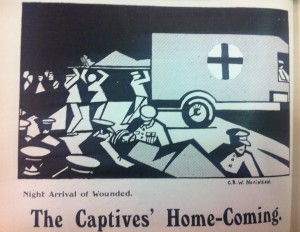The Batstone family, as mentioned in this post, kept the majority of their letters and many diaries, which give a great insight into how one family dealt with the war. They had two young children when Walter was called up, and in this week in June 1916 he was away training whilst Maree tried to handle things at home.
Maree Batstone only wrote one diary entry this week, which started with her receiving two letters from her husband Walter in the morning and afternoon posts. Walter was training in Edinburgh, based in Bruntsfield School, and in his letter explained that he had “been re-drafted + Am now in the 9th draft (when last I sw you I was in the 7th). Dye & I & abot 12 men are on the board tonight as drafted with the 9th draft, isn’t it amusing. I am afraid I have this job at any rate tomorrow – I shall be glad when it is over”.
According to Maree’s diary, the “job” was that of Orderly Corporal – meaning long days, Walter even includes a schedule of his day for her, starting at 4.45am. At 5.30am he had to do the rounds to ask is anyone was going sick and take details, at 6am they had to attend at Gillespie School with a list of defaulters (this is James Gillespie’s School, which is 5- 10 minutes walk away). By 7am he was making out sick reports in triplicate and breakfast was at 7.45am. Lights out were at 10.15pm, after a day of sorting mail and other duties – “you are always on duty and liable to provide men for any emergency – today, two men to fetch beer for the sergeants mess”.
His second latter was dealing more with family business and answering questions she had sent him, including whether or not he required his birth certificate. There was also a complicated answer to a question about the family account with the piano tuner, where it was not clear if the account had been paid – something that became more complex due to all discussions having to be done by post. Maree appeared to be struggling slightly with their daughter Molly, who was a toddler, Walter’s response was hopefully lighthearted: “Am so very sorry you are having such a beast of a time with Molly – she is a naughty little swab-hound and ought to be spanked, can you pack her off (as a boarder) to Em’s School?”
The rest of Maree’s day revolved around cycling into town to get Devonshire cream for her Aunt Emily’s birthday, shopping for her mother, and trying to put the children to bed early – slightly disturbed by a visitor coming after they had been bathed.
Letters from Walter Batstone to Maree, ref: D211/2/1/16
Maree Batstone’s diary, ref: D211/18/2/14


